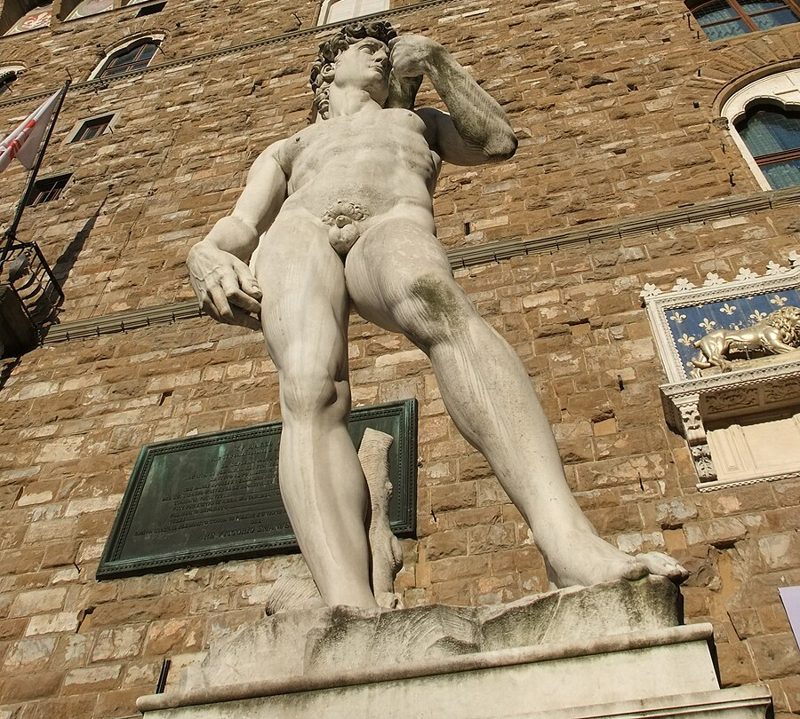Florentine Renaissance
Dear Mom,
I got lost again. This time on the way to the Piazza della Signoria. Luckily, I asked a local craftsman by the name of Dario how I can get to the famous public square. He informed me to “Go up, take a left, then a right, and I should be on my way.” On my way over, I heard whispers about the Medici rule and the contingency of it. That was surprising nonetheless, but the amount of pigeons crowding the streets of Florence was a sight to be seen. A time later, I arrived at the Piazza della Signoria, confused at how many people I saw gathered to my right. Their horrifying stench permeated my nostrils, causing me to take a few steps back. In doing so, I looked up to where they were standing and noticed a marble statue depicting what looked to be a nude male–it stood roughly seventeen feet.(1) Slightly confused, for I had come solely to see the Palazzo Vecchio, I asked a nearby man who called himself Rocco, “what is that?”
“What do you mean, ‘what is that?’”, said Rocco. “That is the infamous David statue by Michelangelo, something an aspiring artist like myself could only dream of completing.”
“Is that like two people or…”, I responded.
1. Joost Keizer, "Giuliano Salviati, Michelangelo and the ‘David," The Burlington Magazine 150, no. 1267 (2008): 665, http://www.jstor.org/stable/40479899.
Austin Lester
7 chapters
16 Nov 2023
David
Piazza della Signoria
Dear Mom,
I got lost again. This time on the way to the Piazza della Signoria. Luckily, I asked a local craftsman by the name of Dario how I can get to the famous public square. He informed me to “Go up, take a left, then a right, and I should be on my way.” On my way over, I heard whispers about the Medici rule and the contingency of it. That was surprising nonetheless, but the amount of pigeons crowding the streets of Florence was a sight to be seen. A time later, I arrived at the Piazza della Signoria, confused at how many people I saw gathered to my right. Their horrifying stench permeated my nostrils, causing me to take a few steps back. In doing so, I looked up to where they were standing and noticed a marble statue depicting what looked to be a nude male–it stood roughly seventeen feet.(1) Slightly confused, for I had come solely to see the Palazzo Vecchio, I asked a nearby man who called himself Rocco, “what is that?”
“What do you mean, ‘what is that?’”, said Rocco. “That is the infamous David statue by Michelangelo, something an aspiring artist like myself could only dream of completing.”
“Is that like two people or…”, I responded.
1. Joost Keizer, "Giuliano Salviati, Michelangelo and the ‘David," The Burlington Magazine 150, no. 1267 (2008): 665, http://www.jstor.org/stable/40479899.

With a distaste Rocco exclaimed, “How dare you? Michelangelo was only born ‘under a lucky star’, almost guaranteed to ‘produce marvelous and stupendous works of art and genius’. He even lived with the great Lorenzo for four years, [eating] ‘continually at his table with his sons and the noble persons who were around his Magnificence.’(2) Maybe if we go a little closer you will be able to see.” And as we got closer, everything started to piece itself together. This is a depiction of the great David from the Bible. Remember when David, on behalf of the Philistines, confronted Goliath with just his sling, rock, and faith in God? He then hurled the rock at Goliath's head and cut it off once he hit the ground. Well, here the veins on his right hand pulsate, while the thigh muscles flex, yet and still, the gaze remains fixed. The bird poop from pigeons, and roughened surface from lighting don’t take away from the tout torso of a man who is resolute.(3) Just as I begin to find more details, Rocco asks, “Did you know the great Michelangelo barely slept or ate when making this masterpiece? Better yet he slept with his boots and clothes, while working on the project in secrecy?”(4) And before I could respond, he goes, “See this statue is more than just a cast figure. It started out as ‘a piece of marble nine braccia in size’(5) unwanted by artists such as Agostino di Duccio and Antonio Rossellino. It took four days, forty men, and even a torn down arch to move the piece.(6) It shows David before the battle as opposed to after, which is a contradiction to previous figures, but an ode to humanist ideals where success was dependent upon intellect and belief."(7) Now understanding, I said, “so David is a symbol of independence, courage, and spry confidence amidst control from the Medici Rule and other city-states. These people see David in a political center like Piazza della Signoria and gain a resurgence for the future.” With a smile on his face, Rocco scurried away, leaving a trail of must as he left.
2. Giorgio Vasari, The Lives of the Artists, eds. and trans. Julia Conaway Bondanella, Peter
Bondanella (New York: Oxford University Press, 2008), 336.
3. Keizer, "Michelangelo and the ‘David," 666.
4. Michelangelo Buonarroti, The Letters of Michelangelo, trans. E.H. Ramsden (Stanford: Stanford University Press, 1963), 279.
5. Vasari, The Lives of the Artists, 412.
6. Buonarroti, The Letters of Michelangelo, 281.
7. Keizer, "Michelangelo and the ‘David," 667-8.
Share your travel adventures like this!
Create your own travel blog in one step
Share with friends and family to follow your journey
Easy set up, no technical knowledge needed and unlimited storage!